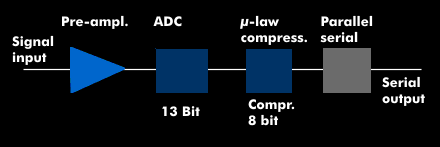µ law method
The µ-law process is a process with which the dynamic range of an audio signal is increased before digital transmission. This process is described in ITU RecommendationG.711 and is used in PCM systems.
In µ-law compression, the dynamic range is increased by first sampling the signal at a higher bit rate and then compressing the data to a lower bit rate using a specific algorithm. The receiver of such a signal works in exactly the opposite way and restores the original higher bit rate.
Like the A-law method, the µ-law method also works with nonlinear characteristics and uses different quantization levels than the A-law method. Determining the bit rate is somewhat problematic in the µ-Law method because the quantization samples are coded logarithmically with 8 bits, whereas their dynamic range is coded linearly with 13 bits. µ-Law has a steeper dynamic characteristic curve in the low level range than the A-Law method.
The µ-law method is used in ISDN in the USA and Japan because the ISDN technology there requires alternating bit states to generate the clock signal and cannot process continuous 0 sequences.

